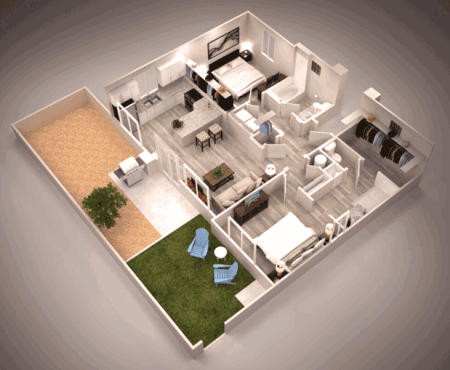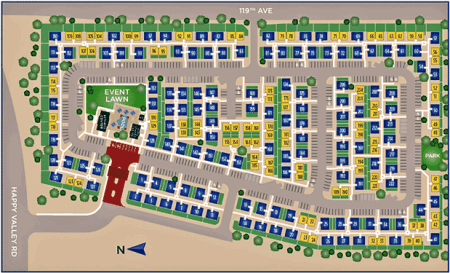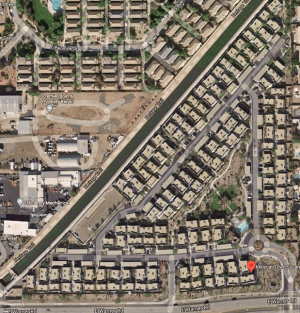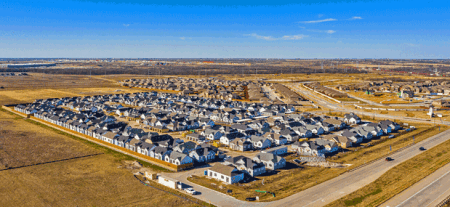Developers build single-story, single-family detached housing units in multifamily communities to rent at premiums over multistory projects.
The American dream of single-family detached (SFD) housing reached its apotheosis in the 20th century. In the 21st century, after the devastation of housing markets led to wholesale acquisition by private-equity firms of massive numbers of SFD homes in the wake of the Great Recession, SFD rentals by property management companies created a new asset class.
Reduced housing production relative to increasing demographic demand resulted in rising home prices. With stagnant wages, significant student loan debt, and minimal savings, many millennials are priced out of the for-sale market, driving demand higher for SFD rentals. In addition, higher management costs for scattered SFD portfolios on individual lots led developers to create SFD rental communities.
Now a newer segment of the market focuses on building horizontal, single-story SFD units on a single plat in multifamily communities to rent at premiums over multistory rental projects. Various factors underlie the new horizontal multifamily detached (HMFD) development niche.
Planning
In order for it to be affordable to build an adequate number of units to realize both development and management efficiencies, HMFD developments tend to be in the range of 150 to 200 units. Because units are small—600 to 1,200 square feet (56 to 112 sq m)—and one-story, project sites for that scale are about 12 to 15 acres (5 to 6 ha) and yield densities of about 13 units per acre (33 per ha). Developers aim for economy rather than density, so they are looking for land cheap enough for a project rather than to achieve a density target.
To find developable land of that size at land prices low enough to enable competitive market rents, developers have built HMFD projects in peripheral areas about 18 miles (30 km) from city cores, although Phoenix-based Christopher Todd Communities at Stadium in Glendale is only 13 miles (21 km) from downtown Phoenix. While the HMFD niche blossomed around Phoenix, the epicenter of HMFDs, it has spread across the Southwest and Southeast to cities like Tucson, Dallas, Denver, and Tampa.
Given small suburban communities’ general preferences, zoning for HMFDs is more difficult to obtain than for for-sale SFDs, but easier to acquire than for denser vertical multifamily rental projects. More-flexible zoning in Phoenix accommodates HMFDs. The stated code purpose of zoning district R-3A, a planned multifamily residential zone, is “to provide flexibility as to unit placement, variable yard requirements, more reasonable and practical use of open spaces.” It allows up to 22 units per gross acre (54 per ha).
Large parcels purchased from sellers to be developed and held as rental communities by single entities make platting for HMFDs simpler than for build-to-rent housing on individual lots. In Justin, Texas, 19 miles (31 km) north of Fort Worth, another major HMFD developer, Phoenix-based NexMetro Communities, obtained planned-unit zoning that provided waivers of setbacks, open space, building separation, and sign location to allow what it termed a “cottage community”—Avilla Reserve, made up of 227 units sited on 19 acres (8 ha), yielding 12 units per acre (30 per ha).
Foreign governments incentivize build-to-rent projects to increase housing supply. In July 2020, New South Wales, a state on the southeastern coast of Australia, announced it would provide an incentive of a 50 percent reduction in land tax and exemption for foreign investor land tax surcharges on qualifying build-to-rent projects.
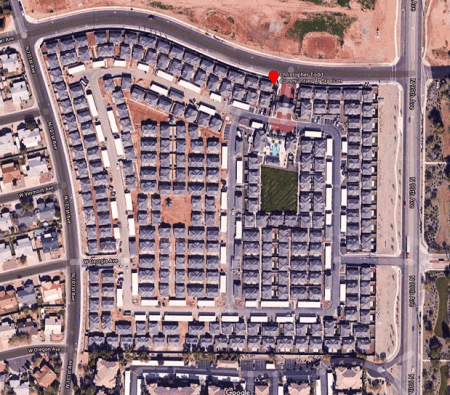
Christopher Todd Communities at Stadium provides perpendicular parking at two spaces per unit along internal parking bays. Separating the units from parking means that units can be placed behind one another as deep as four to five units, accessible via paths, thereby increasing project site productivity.
Design
Site design of HMFDs maximizes efficiency. Gating the parcel at a single location reduces curb cuts and traffic considerations while the enhanced security and exclusivity increase rent premiums. Internal circulation is reduced essentially to linear parking lots of 60-foot-wide (18.3 m) bays with a drive aisle flanked by perpendicular parking spaces.
Parking ratios are close to two spaces per unit—what Christopher Todd Communities at Stadium provides, 630 spaces for 313 units. Carports cover many of those spaces. Christopher Todd Communities on Happy Valley in Peoria, Arizona, has 420 spaces for 222 units, with about 5 percent of those in four-car detached garages. Separating the units from parking means units can be placed behind one another as deep as four to five units, accessible via paths, thereby increasing project site productivity.
Each unit typically has its own walled open space about eight feet wide (2.4 m) and the length of the unit, from 30 to 40 feet (9 to 12 m). Those areas are larger and more private than would be available with balconies on vertical multifamily housing, and many have pet doors leading to them. Because all units are one story, privacy within the open space is preserved, and because no units are located above, the units can have higher inside ceilings—about 10 feet (3.3 m).
The single-story detached units yield some spatial economies. Unlike vertical multifamily projects, there are no common-area hallways, lobbies, elevators, or stairways. Especially during the pandemic, the absence of those features has attracted renters of vertical multifamily units embracing social distancing. Compared with townhouses, there are fewer internal hallways and no staircases or plumbing chases, and because each unit is detached, it can have windows on up to four sides, enhancing access to natural light and facilitating cross ventilation.
HFMD developers also tout the fact there are no shared walls or ceilings/floors with neighbors above, below, or beside the units. Hipped roofs, stucco siding, and other materials can emulate surrounding residential areas. The developers also typically apply higher interior design standards requiring more durable finishes—for example, hardwood floors and granite counters that reduce maintenance, repair, and replacement costs.
Construction
Compared with typical vertical multifamily projects, HMFDs offer several construction economies. Single-family homebuilding is typically the most common construction type and uses readily available supplies of labor and materials. Foundations for single-story SFD units are simpler than for multiple-story projects, although their length is increased. Wood-framed construction is commonly the least expensive option, notwithstanding recent volatility in lumber prices. Engineered wood products, standard sizing of windows and doors, and pre-manufactured roof trusses reduce costs.
Building 150 to 200 units at a time can be more efficient for a single builder/owner than speculative homebuilding against presale orders. Reducing homebuilding to two or three layouts with no choice of finishes reduces the need for coordination during construction. The ability to sequence units contiguously allows fewer crews and specialized tradesmen to move down a horizontal assembly line.
The same holds true for scheduling and completing building inspections, which can often delay projects. Large homebuilders, which are often joint venture partners with HMFD developers—as Taylor-Morrison is with Christopher Todd Communities in multiple locations—have been able to rationalize the building process in order to seek and find economies to enable lower construction costs. Many other large homebuilders also have entered the marketplace, enabling them to employ their crews consistently and have a prearranged sale to a single buyer. Construction liability is greatly reduced compared with condominium development with its often litigious condominium associations.
Economics
Economics is a driving force behind HMFDs. The current median home price in Maricopa County around Phoenix is $411,000. To buy with a customary 20 percent downpayment would require more than $82,000. In Denver, the median home price is $585,000, requiring a $117,000 downpayment. In Tampa, the median home price is $345,000, requiring a $69,000 downpayment. Saddled with student debt, millennials have minimal savings. CNBC reported that 61 percent of millennials between ages 25 and 34 have less than $10,000 in their savings accounts. According to a Unison Home Buyer Survey, 43 percent of the members of this age group have saved less than $3,000 for a downpayment.
Median household income in Phoenix, Denver, and Tampa ranges from $58,000 to $64,000, meaning that devoting one-third of the household income for total housing costs would come to about $1,700 per month. Even at a 10 percent downpayment of $41,000, the monthly mortgage costs alone, at current favorable rates, are about $1,600, plus real estate taxes and insurance. Rapidly rising housing prices are increasingly unaffordable for such potential buyers. Redfin reports that in May 2021, Maricopa County home prices were up 32.6 percent from the previous year, reaching the $411,000 median price.
HMFD developers are building units small enough to be affordable to rent for those who increasingly are renters by necessity. For example, at Christopher Todd Communities on Happy Valley, units range from offering one bedroom and one bath in 647 square feet (60 sq m) of space for $1,420 per month, to two-bedroom, two-bath units of 995 square feet (92 sq m) for $1,900 per month. Renters by choice at Christopher Todd Communities at Stadium can rent a two-bedroom, two-bathroom, 1,022-square-foot (95 sq m) unit for as much as $3,121 per month.
Demographics
HMFDs are particularly attractive to a variety of millennials, especially those who are younger, are saddled with student debt, and have not been able to save enough for SFD downpayments. Those who are older may have been burned by the housing boom and bust that caused the Great Recession and may be averse to the burdens and risks of homeownership.
Many marriages dissolved shouldering the economic turmoil in the decade following the Great Recession. For families headed by a single parent, living in a secure location with common amenities of a pool, gym, and clubhouse is attractive. Millennials are likely to be in peak childbearing years, and many want the security of SFD living without its burdens. Private, walled open space for toddlers and pets, gated entry, and technology- based security appeal to those cohorts.
The adult parents of such millennials may be attracted to the same community. Downsizing grandparents, particularly those who are single, may want to be near and help rear their young grandchildren. With a shortage of available SFDs, it is often hard to find nearby houses in growing cities. Renting smaller ones gives them an opportunity for trial locations and lifestyles.
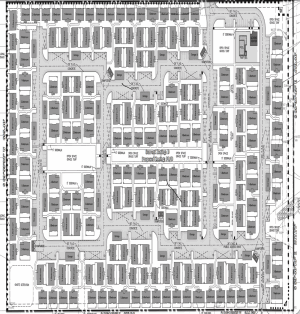
In Justin, Texas, NexMetro Communities obtained planned-unit zoning that provided waivers on setbacks, open space, building separation, and sign location in order to allow a community of 227 units called Avilla Reserve on 19 acres (8 ha), yielding 12 units per acre (55 per ha). (NexMetro Communities)
Management
HMFD developers report that the demographic groups attracted to the product lease for longer periods, reducing turnover compared with vertical multifamily units. The continued shortage of alternative SFD housing and its decreasing affordability due to prices rising faster than incomes likely account for that phenomenon. Many developers retain separate large professional management companies that market and manage both vertical and horizontal projects. For example, Christopher Todd Communities retains Greystar, the largest American apartment rental manager. In contrast with SFD condominium project management, decision- making is more efficient.
Because there are no internal common areas, 100 percent of the built space is rentable, except for the clubhouse. In turn, common-area heating, cooling, and maintenance are eliminated. However, most HMFDs are still too new to have experienced added expenses for replacement costs. HMFD projects have at least four to six times as many roofs and gutters as vertical multifamily projects and about four times as much siding, meaning replacement reserves must be higher, as well.
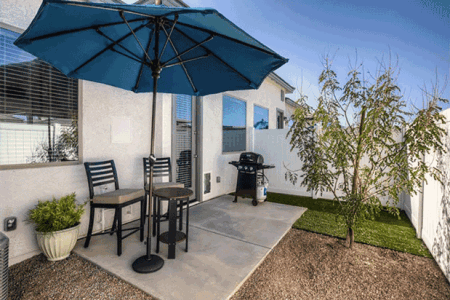
Each Christopher Todd Communities unit typically has its own walled open space about eight feet (2.4 m) wide and the length of the unit, from 30 to 40 feet (9 to 12 m). Those areas are larger and more private than would be available on balconies in vertical multifamily housing. They are walled, and many have pet doors leading to them. (Christopher Todd Communities)
Finance
HMFDs are now recognized as an additional asset class that is attractive to investors. Especially with reduced office and retail development during the Great Recession—and particularly as a result of the pandemic that diminished returns—private equity is attracted to the relative safety and higher occupancies of larger-scale residential projects during a time of growing housing shortages.
Christopher Todd Communities at Stadium was sold to Oak Brook, Illinois–based Inland Real Estate Acquisitions on behalf of the Inland Real Estate Group of Companies for a reported $82.9 million, or $265,000 per unit. With units ranging from 668 to 1,022 square feet (62 to 95 sq m), the sales price equates to $314 per square foot ($3,380 per sq m) for the 845-square-foot (79 sq m) unit average. The Stadium property was 97 percent leased and 95 percent occupied when the sale closed in November 2020.
NexMetro Communities sold its 152-unit, 15-acre (6 ha) Avilla Town Square in Gilbert, Arizona, 18 miles (30 km) southeast of Phoenix, to Utah-based Keller Investment Properties for $42.6 million, or $280,000 per unit. Its units range from 635 to 1,236 square feet (60 to 115 sq m) and rent for $1,554 to $2,254. The sales price equates to $300 per square foot ($3,380 per sq m) for the 936-square-foot (87 sq m) unit average.
NexMetro has developed more than 30 projects in Phoenix, Denver, Dallas, and Tampa. Costs are not available, but public records show that in June 2020 NexMetro paid $3.57 million for a 13-acre (5.3 ha) site in Odessa, 17 miles (27 km) northwest of Tampa, to develop its 152-unit Avilla Suncoast project. The resulting density is 12 units per acre (30 per ha) and a raw land cost of $23,500 per unit.
A long-term-hold investment buyer can realize capital-gains tax advantages in an appreciating market. Institutional investors appear to like the involvement of national homebuilders, including Lennar, DR Horton, and Toll Brothers, in build-to-rent products.
J.P. Morgan Asset Management, the asset management arm of JPMorgan Chase, has a $625 million equity joint venture with American Homes 4 Rent to build about 2,500 single-family rentals in western and southeastern high-growth markets. American Homes 4 Rent, which owns 52,776 single-family rentals across 22 states, was started in October 2012 by B. Wayne Hughes, the founder of Public Storage.
Other institutional investors also have made major commitments to this asset class. California State Teachers Retirement System (CalSTRS) and Pacific Coast Capital Partners recently formed a $1 billion joint venture to invest in the build-to-rent sector. Their first five build-to-rent properties are in Atlanta, Jacksonville, Nashville, and Raleigh.
Suburban Minimalism
The emergence of HMFDs is a particularly suburban phenomenon. The original Levittown house was 750 to 1,000 square feet (70 to 93 sq m), with a living room, a kitchen, two bedrooms, one bathroom, and an unfinished expansion attic on a 5,000- to 6,000-square-foot (465 to 557 sq m) lot. Most had attached carports or garages. They were located on 30-foot-wide (9 m) public streets, with on-street parking in 50-foot-wide (15 m) rights-of-way, including sidewalks and planting strips filled with street trees on both sides. Their density and form were not that different from the SFDs on an urban lot that still predominate in most cities.
HMFDs are a distillation of that model to its minimal similarity. Their equivalent lot size is the minimum to maintain detachment. Frontage on a public street is replaced with access through a gated entry. Parking in a private garage or carport attached to the house is replaced by access to communal parking on a perpendicular parking bay. Expansion space in an attic or garage, which many have found useful for home offices and storage during the pandemic, is eliminated. Individually platted and owned lots are replaced by a single plat held by corporate investors. Annual rentals replace homeownership and mortgages.
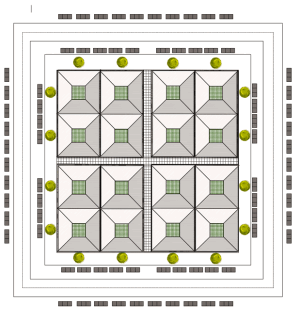
Atrium quad courtyard houses are an alternative to HMFDs, yielding 16 courtyard houses per net acre (40 per ha) inside traditional city blocks. They contain two bedrooms, two baths, plus an accessory dwelling unit and a two-car garage in 2,000 square feet (186 sq m) of enclosed area around a 16-by-16-foot (5 by 5 m) glass-enclosed atrium. (Macht & Company)
Urban Alternatives
Urban alternatives exist that can offer larger houses at equivalent densities, but they require deviation from the American enshrinement of detachment. The Solution File article “Courting Density” in the March/April 2014 issue of Urban Land explored 1,660-square-foot (154 sq m), single-level, two-bedroom, two-bath, three-courtyard houses with two-car garages built in Dallas at 12 units per acre (30 per ha). The Solution File article “Courtyard House Clusters Offer Post-Pandemic Appeal” in the Spring 2021 issue examined a similar format—“atrium quad” courtyard houses containing two bedrooms, two baths, plus an accessory dwelling unit (ADU) and a two-car-garage in 2,000 square feet (186 sq m) of enclosed area around a 16-by-16-foot (5 by 5 m) glass-enclosed atrium. Atrium quad projects yield 16 courtyard houses per net acre (40 per ha) inside traditional city blocks.
Either type of courtyard house could be rented or sold on individual fee-simple lots. Suburbs in which HMFDs are currently being built have ample land for such urban alternatives, and the kinds of zoning incentives in the Phoenix code should allow them. The development model would be different, but the ability of developers to either rent or sell courtyard houses would create alternative exit strategies that would lower their risks and potentially increase their rewards.
If the development community is ready to detach itself from the enchantment of SFDs to try single-family, single-story attached courtyard houses, they can be developed at a scale to compete with SFDs and HMFDs, as well as appeal to diverse ages, incomes, and household sizes.
WILLIAM P. MACHT is a professor of urban planning and development at the Center for Real Estate at Portland State University in Oregon and a development consultant. (Comments about projects profiled in this column, as well as proposals for future profiles, should be directed to the author at [email protected].)
ULI released the report Low-Density Rental Housing in America, which examines the single-family rental market. The report, prepared jointly by the ULI Terwilliger Center for Housing and RCLCO, is available on Knowledge Finder.
Recent Articles by William Macht:
- Solution File: Shared Parking Leads to Creative Solutionsl
- Solution File: Courtyard House Clusters Offer Post-Pandemic Appeal
- Drones for Development
- Solution File: A City Center at the Fringe
- How to Build Livability—and Value—on a Deep, Narrow Infill Lot
- Bringing Mixed Uses—and Open Space—to a Multiple-Small-Block Development in Portland
- The Rise of Pop-up Hotels

